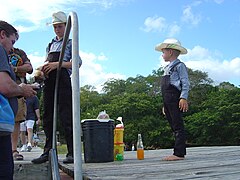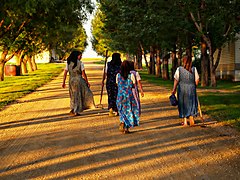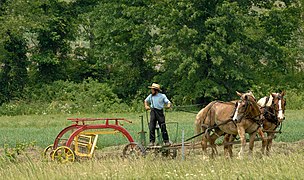Plain dress

Plain dress is a practice among some religious groups, primarily some Christian churches in which people dress in clothes of traditional modest design, sturdy fabric, and conservative cut. It is intended to show acceptance of traditional gender roles, modesty, and readiness to work and serve, and to preserve communal identity and separation from the immodest, ever-changing fashions of the world.
Practicing groups
The practice is generally found among the following Anabaptist branches: Amish (Old Order Amish, New Order Amish, Kauffman Amish Mennonites, Beachy Amish Mennonites), Para-Amish (Believers in Christ, Vernon Community, Caneyville Christian Community), Mennonites (Old Order Mennonites, Conservative Mennonites, traditional "Russian" Mennonites), Hutterites, the Bruderhof Communities, and Brethren (Old Order River Brethren, Old Brethren, Old German Baptist Brethren- New Conference, Dunkard Brethren).[citation needed] Plain dress is also practiced by Conservative Friends and Holiness Friends (Quakers), in which it is part of their testimony of simplicity,[1] as well as Cooperites (Gloriavale Christian Community) and fundamentalist Mormon subgroups.[2][3]
Among the Amish and other plain groups, plain dress is not considered to be a costume but instead is an expression of their religious philosophy.[4] Plain, simple and serviceable gender-identifying dress is governed by an unwritten code of conduct, called "ordnung" among Anabaptists, which is strictly adhered to by Amish, Old Order Mennonites, and conservative Brethren.[5]
Many Apostolic Lutherans also wear plain dress.[6]
Historically, Methodists were known for wearing plain dress, a tradition carried on by a few members in the conservative holiness movement, such as communicants of the Allegheny Wesleyan Methodist Connection and Evangelical Wesleyan Church,[7][8] as well as some Pentecostal denominations in the Wesleyan-Arminian tradition.[6]
Members of the Moravian Church traditionally wore plain dress.[9]
Traditional Adventists wear plain dress as taught by the founder of that faith Ellen White, who asked that they "adopt a simple, unadorned dress of modest length".[10] Adherents of the Seventh-day Adventist Church have historically not worn wedding rings.[11]
Other groups adhering to a conservative dress code include Buddhist and Christian monks, Orthodox Jews, and Muslim women, but these forms of dress normally are not called "plain dress".
Practices
Plain dress is attributed to reasons of theology and sociology.[3] In general, plain dress involves the covering of much of the body (often including the head, forearms and calves), with minimal ornamentation, rejecting print fabrics, trims, fasteners, and jewelry. Non-essential elements of garments such as neckties, collars, and lapels may be minimized or omitted. Practical garments such as aprons and shawls may be layered over the basic ensemble. Plain dress garments are often handmade and may be produced by groups of women in the community for efficiency and to ensure uniformity of style. Plain dress practices can extend to the grooming of hair and beards and may vary somewhat to allow children and older people more latitude.[12]
Within these general practices, distinctions abound. In some groups, for example, the women's preferred head covering is lacy or translucent; in others, it must be opaque.
Anabaptist
The traditional plain dress worn by the Anabaptists and other religious groups has long sleeves with a set waist, long skirt, and no adornment. It denotes "utility, modesty, long wear and inconspicuousness", does not display any trademark, and is not dictated by fashion trends. Shawl, aprons, bonnets and cap are part of plain dress.[13]
Clothing worn by Bruderhof women includes a headcovering,[14] as well as long skirts or dresses; men wear contemporary clothes of a modest nature.[citation needed]
Quaker
As a part of their testimony of simplicity, Quakers (Religious Society of Friends) traditionally wore plain dress; "Ruffles and lace and other forms of ornamentation, as well as unnecessary cuffs and collars and lapels and buttons, were forbidden."[15][16] George Fox implored fellow Quakers to wear plain dress:[17]
Friends, keep out of the vain fashions of the world; let not your eyes, minds, and spirits run after every fashion (in attire) of the nations; for that will lead you from the solid life into unity with that spirit that leads to follow the fashions of the nations, after every fashion of apparel that gets up: but mind that which is sober and modest, and keep to your plain fashions, that you may judge the world's vanity and spirit, in its vain fashions, and show a constant spirit in the truth and plainness.[17]
This classical Quaker belief practice continues to be maintained by Conservative Friends, as well as the Central Yearly Meeting of Friends.[15][1]
Methodist

Early Methodists wore plain dress, with Methodist clergy condemning "high headdresses, ruffles, laces, gold, and 'costly apparel' in general".[8] John Wesley, the founder of the Methodist movement, recommended that Methodists read his thoughts On Dress, in which he detailed acceptable types and colors of fabrics, in addition to "shapes and sizes of hats, coats, sleeves, and hairstyles";[18] in that sermon, John Wesley expressed his desire for Methodists: "Let me see, before I die, a Methodist congregation, full as plain dressed as a Quaker congregation."[19] He also taught, with respect to Christian headcovering, that women, "especially in a religious assembly", should "keep on her veil".[20][21] Those who tried to attend Methodist services in costly apparel were denied admittance.[22] Wesley's teaching was based on his interpretation of 1 Timothy 2:9–10 and 1 Peter 3:3–4, which he stated led him to conclude that "expensive clothes puff up their wearers, promote vanity, incite anger, inflame lust, retard the pursuit of holiness, and steal from God and the poor."[23] The 1858 Discipline of the Wesleyan Methodist Connection stated that "we would not only ejoin on all who fear God plain dress, but we would recommend to our preachers and people, according to Mr. Wesley's views expressed in his sermon on the inefficiency of Christianity, published but a few years before his death, and containing his matured judgment, distinguishing plainness—Plainness which will publicly comment them to the maintenance of their Christian profession wherever they may be."[24] The 1859 novel Adam Bede portrayed the Methodist itinerant preacher, Dinah Morris, wearing plain dress, with the words "I saw she was a Methodist, or Quaker, or something of that sort, by her dress".[25] Peter Cartwright, a Methodist revivalist, lamented the decline of wearing plain dress among Methodists, stating:[26]
The Methodists in that early day dressed plain; attended their meetings faithfully, especially preaching, prayer and class meetings; they wore no jewelry, no ruffles; they would frequently walk three or four miles to class-meetings and home again, on Sundays; they would go thirty or forty miles to their quarterly meetings, and think it a glorious priviledge to meet their presiding elder, and the rest of the preachers. They could, nearly every soul of them, sing our hymns and spiritual songs. They religiously kept the Sabbath day: many of them abstained from dram-drinking, not because the temperance reformation was ever heard of in that day, but because it was interdicted in the General Rules of our Discipline. The Methodists of that day stood up and faced their preacher when they sung; they kneedled down in the public congregation as well as elsewhere, when the preacher said, "Let us pray." There was no standing among the members in time of prayer, especially the abominable practice of sitting down during that exercise was unknown among early Methodists. Parents did not allow their children to go to balls or plays; tey did not send them to dancing schools; they generally fasted once a week, and almost universally on Friday before each quarterly meeting. If the Methodists had dressed in the same "superfluity of naughtiness" then as they do now, there were very few even out of the Church that would have had any confidence in their religion. But O, how have things changed for the worse in this educational age of the world![24]
While few wear plain dress in mainline Methodism today, some Methodist Churches of the conservative holiness movement, such as the Allegheny Wesleyan Methodist Connection and Evangelical Wesleyan Church, continue to dress plainly,[7][27] also avoiding the wearing of jewelry (inclusive of wedding rings).[28]
Moravian
Historically, members of the Moravian Church wore plain dress:[9]
Their strait, unlapelled, dark brown coat, the broad-brimmed, low-crowned hat, the knee-buckled small clothes, the broad, round-toed shoe, were consistent characteristics of a Moravian brother; whilst the plain drab or black silk bonnet, the three-corned white kerchief, the plain silk gown (Sunday dress), the comfortable hood-finished cloack, the "stuff" shoe, for comfort and convenience, were the sisters' concession to St. Peter's advice, "whose adorning, let it not be that outward adorning of plaiting the hair, and wearing of gold, or putting on of apparel."[9]
Theological bases
Plain dressing Christians cite Paul's advice to the Romans, "Be not conformed to this world," as one Biblical basis for their distinctive dress. Other scripture passages counsel women to wear head coverings while praying (1 Corinthians 11:5), not to cut their hair (1 Corinthians 11:14–15), and for men not to shave or cut their beards (Leviticus 19:27).[29]
The rejection of extravagant clothing is further established in 1 Timothy 2:9–10[30][31]
[T]hat women adorn themselves in modest apparel, with shamefacedness and sobriety; not with broided hair, or gold, or pearls, or costly array; but (which becometh women professing godliness) with good works.
Some Mormon Fundamentalist groups such as the FLDS wear plain dress, referring both to Biblical and unique Latter Day Saint Scriptures, such as the Book of Alma and the Doctrine and Covenants, which states, "Thou shalt not be proud in thy heart; let all thy garments be plain, and their beauty of the work of thine own hands" (42:40).[32]
Social effects
Plain dress may establish a sense of belonging within the community while also marking the group's members as different in the wider society. Some practitioners describe their dress as a protection from unwanted attention. Quaker minister Elizabeth Fry considered her plain dress to serve as "a hedge against the world", and "a sort of protector".[33] Marketing through the internet has these sites which propagate plain dress: "Quaker Jane", "Plain and Simple Headcoverings", "Rachel’s Seamstress Services" and "Mennonite Maidens".[3]
Simple dress, considered "sensible and useful" and necessary, is sometimes hard to find as the clothing market is dictated by fashion conscious people who consider plain dress dull.[34]
In literature
Dressing heroines in Victorian literature in plain dress is often assumed to be a way of making characters appear classless and sexless.[35] Others argue that authors like Charlotte Brontë, George Eliot, and Anthony Trollope use plain dress to highlight the marriageability of the character, sexualizing her by emphasizing the female body within.[35][36] Additionally, plain dress may signify a character's rejection of societal norms and willingness to leave the household to act on her desires.[35]
Gallery
-
Pennsylvania Dutch Mennonite woman in 1942
-
An Old Colony Mennonite family in Campeche, Mexico
-
Schmiedeleut Hutterites at school
-
Schmiedeleut Hutterites singing a hymn
-
Schmiedeleut Hutterite women at work
-
Schmiedeleut Hutterite women return from working in the fields
-
Amish in Aylmer, Ontario
-
Amish women at the beach, Chincoteague, Virginia
-
Amish children on the way to school
-
Amish man from one of the very plain "one suspender" groups in southeast Ohio
See also
References
- ^ a b Manual of Faith and Practice of Central Yearly Meeting of Friends. Central Yearly Meeting of Friends. 2018. p. 107–110.
- ^ Scott, Stephen (1986). Why Do They Dress That Way?. Intercourse, PA: Good Books.
- ^ a b c Yoder, Jeremy (15 September 2010). "Plain Dress: Wednesday Link Potluck: Not Dressing Like Lady Gaga Edition". Eastern Mennonite University. Archived from the original on 17 August 2016. Retrieved 31 August 2015.
- ^ "Amish People and Amish Culture". LancasterPA.com. Retrieved 2 September 2015.
- ^ "Amish: Out of Order Facts – What You Probably Don't Know About the Amish". National Geographic. Retrieved 2 September 2015.
- ^ a b Scott, Stephen (1 September 2008). Why Do They Dress That Way?. Good Books. p. 53. ISBN 9781680992786.
- ^ a b "I. The Church". Discipline of the Allegheny Wesleyan Methodist Connection. Allegheny Wesleyan Methodist Connection.
Should we insist on plain and modest dress? Certainly. We should not on any account spend what the Lord has put into our hands as stewards, to be used for His glory, in expensive wearing apparel, when thousands are suffering for food and raiment, and millions are perishing for the Word of life. Let the dress of every member of every Allegheny Wesleyan Methodist Church be plain and modest. Let the strictest carefulness and economy be used in these respects.
- ^ a b Lyerly, Cynthia Lynn (24 September 1998). Methodism and the Southern Mind, 1770-1810. Oxford University Press. p. 39. ISBN 9780195354249. Retrieved 19 June 2017.
- ^ a b c Ritter, Abraham (1857). History of the Moravian Church in Philadelphia. Hayes & Zell. p. 145. Accessed 19 June 2017.
- ^ Robinson, D. E. (1990). "Adopt%20a%20Simple,%20Unadorned%20Dress" "Seventh-day Adventists and the Reform Dress". The Ellen G. White Estate, Inc. Retrieved 17 July 2018.
- ^ Review and Herald: Official Organ of the Seventh-Day Adventist Church. Seventh-day Adventist Church. 1967. p. 14.
In the United States, Seventh-day Adventist ministers do not baptize a person wearing a wedding ring, nor do they officiate at a wedding in which the ring ceremony is part of the service.
- ^ Reynolds, Margaret C.; Bronner, Simon J. (2001). Plain Women: Gender and Ritual in the Old Order River Brethren Penn State Press. pp. 61–96. ISBN 978-0-271-02138-6
- ^ McKean, Erin (2013). The Hundred Dresses: The Most Iconic Styles of Our Time. A&C Black. p. 20. ISBN 978-1-4081-9050-0.
- ^ Wollaston, Sam (23 July 2019). "'Just don't call it a cult': the strangely alluring world of the Bruderhof". The Guardian. ISSN 0261-3077. Retrieved 22 October 2019.
- ^ a b Hamm, Thomas D. (2006). The Quakers in America. Columbia University Press. p. 102. ISBN 978-0231123631. Accessed 19 June 2017.
- ^ F., José Blanco; Hunt-Hurst, Patricia Kay; Lee, Heather Vaughan; Mary Doering (23 November 2015). Clothing and Fashion: American Fashion from Head to Toe [4 volumes]: American Fashion from Head to Toe. ABC-CLIO. p. 1. ISBN 978-1610693103. Accessed 19 June 2017.
- ^ a b Evans, William; Evans, Thomas (1837). The Friends' Library. J. Rakestraw. p. 132. Accessed 19 June 2017.
- ^ Journals of Wesley, Nehemiah Curnock, ed.,London: Epworth Press 1938, p. 468.
- ^ Wesley, John (1999). "The Wesley Center Online: Sermon 88 - On Dress". Wesley Center for Applied Theology. Retrieved 19 June 2017.
- ^ Wesley, John (1987). Wesley's Notes on the Bible. Christian Classics Ethereal Library. p. 570. ISBN 9781610252577.
Therefore if a woman is not covered — If she will throw off the badge of subjection, let her appear with her hair cut like a man's. But if it be shameful far a woman to appear thus in public, especially in a religious assembly, let her, for the same reason, keep on her veil.
- ^ Dunlap, David (1 November 1994). "Headcovering-A Historical Perspective". Uplook Ministries. Retrieved 24 June 2019.
Although women were allowed to preach in the Methodist ministry, the veil covering a woman's head was required as a sign of her headship to Christ. Concerning the theological significance of the veil, Wesley wrote, "For a man indeed ought not to veil his head because he is the image and glory of God in the dominion he bears over the creation, representing the supreme dominion of God, which is his glory. But the woman is a matter of glory to the man, who has a becoming dominion over her. Therefore she ought not to appear except with her head veiled as a tacit acknowledgement of it."
- ^ Rupert Davies, A History of the Methodist Church in Great Britain, London : Epworth, 1965, p.197.
- ^ Yrigoyen, Charles; Warrick, Susan E. (7 November 2013). Historical Dictionary of Methodism. Scarecrow Press. p. 124. ISBN 9780810878945.
- ^ a b The Discipline of the Wesleyan Methodist Connection, of America. Wesleyan Methodist Connection of America. 1858. p. 85.
- ^ "A Few Historical Quaker Plain Dress References". Quaker Jane. 2007. Archived from the original on 14 September 2017. Retrieved 19 June 2017.
- ^ Cartwright, Peter (1857). Autobiography of Peter Cartwright: The Backwoods Preacher. Carlton & Porter. p. 74. Accessed 19 June 2017.
- ^ Elwell, Walter A. (2001). Evangelical Dictionary of Theology. Baker Academic. p. 564. ISBN 978-0801020759. Accessed 19 June 2017.
- ^ "Discipline of the Bible Methodist Connection of Churches" (PDF). 2014. pp. 33–34. Retrieved 19 June 2017.
- ^ Torrey, Mary Ide (1838). Ornament, or the Christian Rule of Dress Crocker & Brewster.
- ^ B. Schwertley, Pastor. "3: Modesty and Extravagance" (PDF). Modesty in Apparel: Bringing a Believer's Attire into Subjection to the Word of God. Retrieved 4 September 2015.
- ^ Cap Ehlke, Roland (2000). "A Woman's Place: The Evangelical Debate over the Role of Women in the Church". Christian Research Journal. 22 (4). Archived from the original (PDF) on 2007. Retrieved 4 September 2015.
{{cite journal}}: Check date values in:|archive-date=(help) - ^ News, Deseret (24 June 2008). "Web site sells FLDS-style clothes". Deseret News. Retrieved 14 December 2020.
{{cite web}}:|last=has generic name (help) - ^ Caton, Mary Anne (2003). "The Aesthetics of Absence: Quaker Women's Plain Dress in the Delaware Valley, 1790–1900" in Emma Jones Lapsansky and Anne A. Verplanck, eds., Quaker Aesthetics: Reflections on a Quaker Ethic in American Design and Consumption, 1720–1920. University of Pennsylvania Press. pp. 246–271. ISBN 978-0-8122-3692-7
- ^ Rose, Hilary (29 August 2015). "The joys of a perfectly plain dress". The Times.
- ^ a b c Keen, Suzanne (2002). "Quaker dress, sexuality, and the domestication of reform in the Victorian novel". Victorian Literature and Culture. 30 (1). Cambridge University Press: 211–236. doi:10.1017/S1060150302301104. JSTOR 25058582.
- ^ Connerley, Jennifer L. (2006). "Quaker bonnets and the erotic feminine in American popular culture". Material Religion: The Journal of Objects, Art and Belief. 2 (2): 174–203. doi:10.2752/174322006778053636.
External links
- Understanding Plain Dress (Mennonite)
- Plain Resources (Quaker)
- On Dress by John Wesley (Methodist)
- fldsdress (Mormon Fundamentalist, archived)












